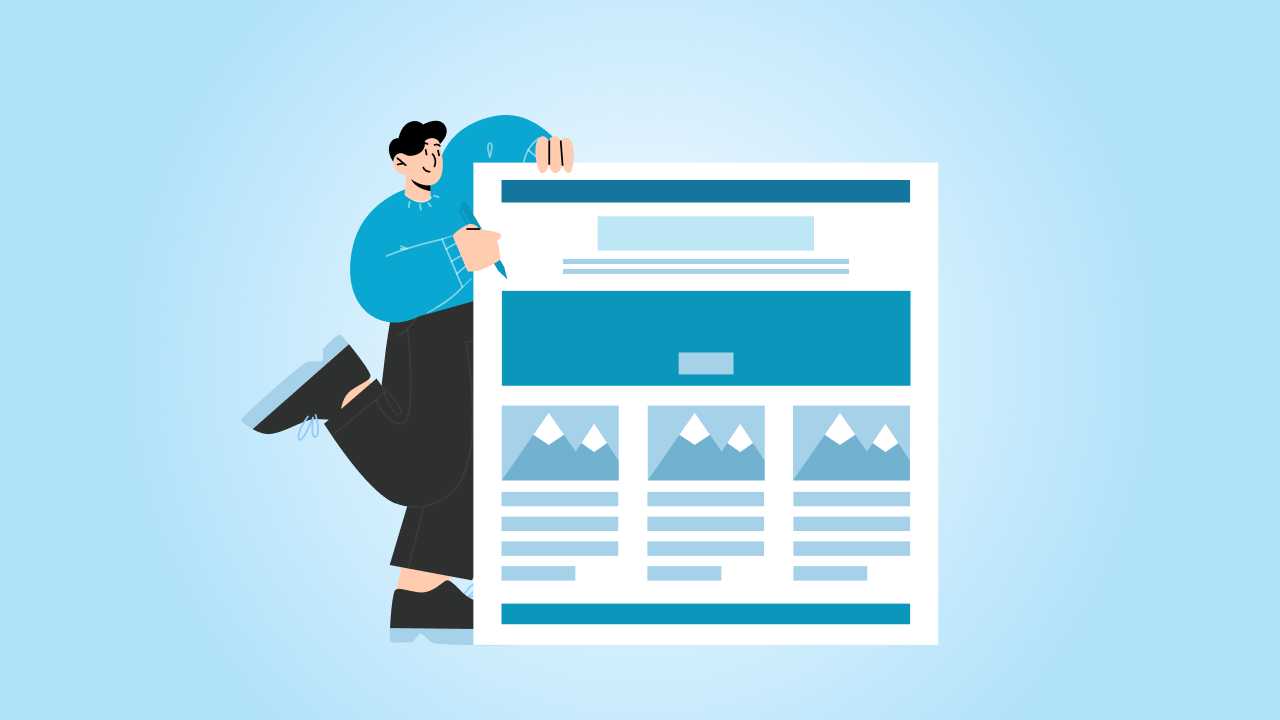A website redesign can be a game-changer for your business, but it’s not something you want to rush into. If your website feels outdated, slow, or just doesn’t meet your needs anymore, redesigning it can make a big difference. However, without a clear plan and timeline, things can quickly go off track.
A lot of businesses face the same challenges when taking on website redesign work: missed deadlines, budget creep, or confusion about the project’s direction. These can all be avoided with the right planning.
This guide is here to help you what is website redesign and avoid common mistakes by breaking down the process into simple, manageable steps. We will help you map out a realistic timeline, so you know exactly what to expect and when. Let’s get started!
Why Does a Website Redesign Need a Timeline?
A clear timeline isn’t just nice to have when redesigning your website; it’s essential for staying on track, managing expectations, and ensuring a high-quality result. Without it, you risk missing deadlines, exceeding budgets, or launching a site that doesn’t meet your business needs. Let’s look at why having a structured timeline is key:
1. Avoiding Scope Creep: How Timelines Help Prevent Delays and Extra Costs
Scope creep happens when the project gradually expands beyond its original goals. You might start with a plan to redesign the homepage and end up adding new features, changing the layout, or completely reworking the content. While this may seem harmless, it can lead to delays, increased costs, and a lack of focus on the project’s core objectives.
A well-defined timeline helps you stay focused on what matters most. It ensures that any changes or additions are carefully considered and managed. Plus, it gives you clear checkpoints to evaluate progress and adjust before things get too off track.
2. Aligning Stakeholders: Setting Expectations for Team Members and Clients
When redesigning a website, you’re likely working with a team of designers, developers, content creators, and maybe even external contractors. If everyone isn’t on the same page about deadlines and goals, it’s easy for confusion and miscommunication to arise.
Having a timeline keeps everyone aligned and ensures that key stakeholders are involved at the right stages. You’ll know when feedback is needed, when approvals are due, and when to expect deliverables. This clarity not only keeps the project moving forward but also helps manage expectations for clients or internal teams.
3. Ensuring Quality: Allowing Time for Thorough Design, Testing, and Revisions
Rushing through a redesign to meet an unrealistic deadline often results in cutting corners—whether it’s skipping user testing, overlooking design details, or missing out on feedback from stakeholders. A well-planned timeline lets you allocate enough time for each stage of the process, ensuring that your website isn’t just launched quickly but is built to last.
Having time for design iterations, testing, and revisions means you can address issues before they become major problems. It also ensures that your website meets all of your functional and aesthetic requirements, creating a final product that reflects your brand and provides an excellent user experience.
cmsMinds has the experience to turn your ideas into a powerful website. Get in touch now to discuss your project and make it happen!
Phases of a Website Redesign Timeline
A successful website redesign doesn’t happen overnight. It involves several stages, each with its own set of tasks and goals. By breaking the process into phases, you can better manage your time and resources, avoid surprises, and track your progress. Here’s an overview of the typical phases of a website redesign timeline:
1. Discovery and Planning (2–4 Weeks)
This phase is all about laying the groundwork for the entire redesign. It’s where you’ll define the project’s scope, identify your goals, and understand what needs to be changed on your current site. The more thorough your planning is here, the smoother the rest of the process will go.
Activities in this phase include:
- Auditing your current website: Review what’s working, and what isn’t, and gather feedback from users and stakeholders.
- Defining goals: What do you want the new custom and responsive website design to achieve? Whether it’s increasing conversions, improving load speed, or making it mobile-friendly, your goals should guide the entire redesign.
- Identifying your target audience: Understanding who will use the site helps shape the design and functionality.
- Mapping user journeys: This involves planning out how users will navigate your site, ensuring the experience is intuitive and smooth.
Deliverables:
- A project brief that includes your goals, objectives, and target audience.
- A sitemap that shows the structure of the new site.
- Wireframes that outline the basic layout and structure of key pages.
2. Design Phase (4–8 Weeks)
Once the planning is in place, the creative work begins. This is where your website starts to take shape, visually and functionally. It’s also the stage where you’ll review, refine, and make adjustments based on feedback.
Activities in this phase include:
- Creating mockups and prototypes: Designers will develop visual mockups that show the look and feel of your website, from the homepage to individual pages.
- Collaborating with stakeholders: During this phase, you’ll get feedback from key stakeholders (like your team or clients) to ensure everyone is aligned on the design direction.
- Refining the design: Based on feedback, you’ll make adjustments, and fine-tune the layout, color schemes, typography, and other visual elements.
Deliverables:
- High-fidelity mockups or clickable prototypes that show the visual design in detail.
- Approval from stakeholders on the final design direction.
3. Development Phase (6–12 Weeks)
Now that the design is finalized, it’s time to bring it to life. During this phase, the designs are translated into code, and the website starts becoming functional.
Activities in this phase include:
- Building the site’s front end: Developers will take the design files and code the structure, layout, and visual elements for the web pages.
- Building the back-end: This is where the functionality of the website is created—setting up content management systems (CMS), integrating forms, and ensuring the website can handle various actions like payments or registrations.
- Mobile responsiveness: The website must look great and function properly across all devices, from desktops to smartphones.
- CMS integration: If you’re using a CMS (like WordPress, Shopify, or others), this phase will involve setting it up so you can easily manage content post-launch.
Deliverables:
- A fully functional version of the website is hosted on a staging server for testing.
- A website that is mobile-responsive and compatible with various browsers.
4. Testing and QA (2–3 Weeks)
Before you launch, it’s critical to ensure everything works smoothly. Testing is where you catch bugs, ensure your site is user-friendly, and make any necessary improvements.
Activities in this phase include:
- Cross-browser testing: Make sure your website works on all major browsers (Chrome, Firefox, Safari, etc.).
- Mobile performance testing: Verify that your site is fully responsive and works on all screen sizes.
- User testing: Conduct tests with real users to identify usability issues or areas for improvement.
- Performance checks: Ensure that your site loads quickly, and optimize it for performance if needed.
- Security audits: Ensure that the site is secure, especially if handling sensitive user data (like payment info).
Deliverables:
- A bug-free website with all issues addressed.
- Final approval to move to the launch stage.
5. Launch and Post-Launch Support (1–2 Weeks)
The moment you’ve been working toward—launch day! But don’t celebrate just yet. This phase includes final checks and post-launch support to ensure everything runs smoothly.
Activities in this phase include:
- Domain and hosting setup: Ensure your domain is properly set up, and the website is hosted on a reliable server.
- Launching the website: Take the website from the staging server to live production.
- Monitoring for issues: Keep a close eye on the website after launch for any unexpected problems or bugs.
- Post-launch testing: Conduct a final round of testing to catch any issues that might have slipped through earlier stages.
Deliverables:
- The website is live and accessible to the public.
- Analytics tracking and other monitoring tools are set up for ongoing performance checks.
Tips for Staying on Track
A website redesign can be an exciting process, but it’s easy to get sidetracked if you don’t stay organized. To keep everything running smoothly and meet your deadlines, here are some practical tips to help you stay on track:
1. Prioritize Communication
Good communication is essential for keeping a project on schedule. This is especially true in a website redesign, where you’ll be working with multiple team members, stakeholders, and possibly clients.
- Set regular check-ins: Weekly or bi-weekly meetings can help everyone stay aligned on progress and quickly address any concerns.
- Document decisions: Keep a running record of decisions made during meetings so there’s no confusion later on.
- Encourage open feedback: Make sure feedback from all team members and stakeholders is welcomed early and often to avoid last-minute changes.
2. Use Project Management Tools
- Staying organized and tracking progress can be challenging, but project management tools make it a lot easier. Tools like Trello, Asana, or Monday.com help you break down tasks, set deadlines, and monitor your project’s status.
- Create detailed task lists: Break down each phase of the redesign into smaller tasks, assigning responsibilities to the right people.
- Set deadlines and reminders: With timelines in place, project management tools help you ensure everyone knows when their work is due.
- Monitor progress: These tools give you a real-time overview of the project, making it easier to spot delays or issues before they become bigger problems.
3. Set Clear Deadlines for Approvals
One of the easiest ways a project can fall behind is when approvals are delayed. Whether it’s the design, content, or final functionality, get everyone’s buy-in early and keep things moving.
- Outline approval timelines: Be clear from the start about when you need feedback and approvals from key stakeholders.
- Factor in buffer time: Leave some room in your timeline for revisions and additional rounds of feedback.
- Be decisive: When it’s time to make decisions, try to avoid too many back-and-forth revisions to keep the project moving forward.
4. Keep an Eye on Budget and Time
It’s easy to go over budget and past deadlines if you don’t keep track of both. A solid timeline helps you stay on track with both time and costs, but you’ll also want to keep an eye on:
- Budget tracking: Use tools or spreadsheets to monitor spending and ensure you’re staying within the budget you’ve set.
- Time management: If a phase starts taking longer than expected, reassess the timeline to avoid delays in later stages.
- Be realistic: Sometimes, you may need to adjust the timeline or scope to keep things on track.
5. Be Prepared for Unexpected Challenges
Even the best-laid plans can encounter roadblocks. Whether it’s a design that doesn’t meet expectations or a development issue that takes longer than planned, expect some challenges along the way.
- Built-in flexibility: Allow for some buffer time in your schedule to account for delays or unexpected issues.
- Have backup plans: In case something doesn’t work out as expected, it’s helpful to have a contingency plan in place so the project doesn’t come to a halt.
- Don’t rush: Quality matters. While it’s important to stay on schedule, rushing through phases like design or testing can result in a subpar final product.
Common Pitfalls and How to Avoid Them
Even with the best plans and a clear timeline, several obstacles can derail your website redesign. These are some of the common mistakes of website redesign and how you can avoid them to ensure a smooth and successful project.
1. Failing to Define Clear Goals
Without clear goals, the redesign can easily drift off course. Whether you are updating your website for improved user experience, better SEO, or more conversion rates, failing to define the specific objectives you want to achieve makes it hard to measure success.
How to avoid it:
- Set measurable goals: Determine the exact outcomes you expect, such as increasing page load speed by 30%, improving mobile usability, or boosting conversion rates.
- Align goals with business needs: Ensure that your website goals directly tie to broader business objectives to keep everyone focused on the bigger picture.
2. Overloading with Features
It’s easy to get excited about adding too many features or complex functionality, but this can complicate the redesign process. A cluttered, feature-heavy website can overwhelm users and lead to slow performance.
How to avoid it:
- Focus on core functionality: Prioritize essential features that directly contribute to the user experience or business goals.
- Limit feature creep: Stick to the original plan and assess new ideas against the time and resources available before adding them to the project.
3. Inadequate Mobile Optimization
Today, mobile users account for a significant portion of web traffic. If you don’t prioritize mobile optimization, your website will leave a large group of users frustrated. Ignoring mobile design or treating it as an afterthought can result in a poor user experience.
How to avoid it:
- Design for mobile-first: Begin by designing for smaller screens and then expand to desktop views. This ensures that the mobile experience is always top of mind.
- Test across devices: Ensure the website works seamlessly across all devices, from smartphones to tablets, with consistent speed and usability.
4. Skipping Content Strategy
Redesigning the website without addressing the content can lead to a site that looks great but doesn’t connect with users. Content plays a huge role in how users engage with your site, and failing to align content with design can confuse visitors.
How to avoid it:
- Plan content early: Review your existing content and determine what should be kept, updated, or removed. Align new content with the redesigned structure to ensure everything flows logically.
- Ensure consistency: Content tone, style, and message should be consistent with the overall branding and user experience goals of the website.
5. Lack of SEO Considerations During Redesign
Redesigning a website without taking SEO into account can undo months or even years of hard work. Whether it’s a new URL structure, changes to the content, or site speed issues, ignoring SEO best practices can hurt your search rankings.
How to avoid it:
- Incorporate SEO early: Work with your development and design team to ensure that the new site is optimized for search engines from the beginning. This includes proper metadata, alt tags, URL structure, and page load speed.
- Monitor during and after launch: Run SEO audits before and after launch to identify and address any issues that may impact your rankings.
6. Underestimating the Importance of User Testing
Testing is often overlooked or rushed, but it’s one of the most crucial steps in the redesign process. A website might look great on paper, but if users don’t find it intuitive or encounter technical problems, it’s not a success.
How to avoid it:
- Include real users in testing: Don’t just rely on your internal team. Engage actual users who match your target audience to test the site’s functionality and usability.
- Test throughout the process: Conduct multiple rounds of testing at different stages (prototype, design, and final build) to catch problems early and refine the site before launch.
7. Ignoring Analytics and Post-Launch Monitoring
Once your site is live, it’s easy to assume the job is done. But neglecting post-launch analytics and monitoring can cause you to miss potential issues or areas for improvement that impact user experience and performance.
How to avoid it:
- Set up monitoring tools: Before launch, integrate tools like Google Analytics, heatmaps, and performance monitoring tools to track how users interact with your site.
- Plan for post-launch updates: Your site should be an evolving project. Monitor user behavior, look for bounce rates, and test new features or tweaks to continuously improve the site over time.
Conclusion
Planning and sticking to a realistic timeline is so important for the success of your redesign project. From setting clear objectives and communicating with stakeholders to tracking performance post-launch, each step plays a vital role in achieving a smooth, successful transition to your new website.
If you have gone through a website redesign or are planning one, we’d love to hear about your experiences. What challenges did you face, and how did you overcome them? If you need guidance or professional help with your redesign, feel free to reach out. We’re here to help make your website redesign process as seamless and successful as possible.
At cmsMinds, we create websites that work for you. Ready to get started on your redesign





